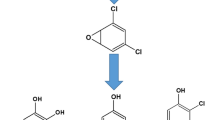Abstract
The reported investigations on the uptake of carbon disulphide (CS2) and the excretion of its metabolite 2-thiothiazolidine-4-carboxylic acid (TTCA) were based on results from 403 personal air samples (352 passive and 51 active samples) and 362 TTCA determinations in biological material measured during a field study on the adverse effects due to CS2 exposure. The external exposure ranged from below the detection limit (0.2 ppm) to 66 ppm and the urinary TTCA excretion from below the detection limit (0.16 mg./1) to 33.4 mg/1. The excretion of TTCA in postshift urine related to creatinine and volume showed a linear correlation to the CS2 air concentration. On the basis of these results the influence on the internal exposure of physical work load, dermal exposure and individual parameters (age, Brocaindex, disturbed skin barrier) was evaluated. Correlations between the TTCA values in the postshift urine and the individually measured CS2 concentrations were carried out separately for individual departments and persons with and without indications of a disturbed skin barrier. In order to be able to judge the individual internal exposure related to external exposure, a personal quotient was formed from the TTCA level in the urine and the CS2 air concentration measured on the same day (relative interal exposure RIE index = TTCA mg/g creatinine/CS2 in ppm). On investigating interindividual differences, higher relative internal exposures were found in persons with a heavy physical work load and more intensive skin contact. It could be shown for a large group of persons exposed to CS2 that a pathological skin condition leads to an increase in the dermal penetration rate of hazardous substances. By means of the RIE index it could be shown that the TTCA excretion related to the individual external exposure increases significantly with a decreasing Broca index, which must be taken into consideration with greatly overweight persons and exposures in the range of the currently valid threshold limit values. The interindividual differences in internal exposure found at the same ambient air concentration emphasize the importance of biological monitoring for individual health protection and the setting of biological threshold limit values.
Similar content being viewed by others
References
Aalto-Korte K, Turpeinen M (1993) Transepidermal water loss and absorption of hydrocortisone in widespread dermatitis. Br J Dermatol 128:633–635
Beauchamp RO, Bus JA, Popp JA, Boreiko CJ, Goldberg L (1983) A critical review of the literature on carbon disulfide toxicity. CRC Crit Rev Toxicol 11:169–278
Berner B, Cooper ER (1987) Models of skin permeability. In: Kydonieu AF, Berner B (eds) Transdermal delivery of drugs vol II. CRC Press, Boca Raton, pp 41–55
BUA-Advisory Committee of the GDCh on Existing Chemicals of Environmental Relevance (1993) Carbon disulfide. BUA report 83. S. Hirzel, Stuttgart
Campell L, Jones AH (1985) Wilson KH (1985) Evaluation of occupational exposure to carbon disulfide by blood, exhaled air and urine analysis Am J Ind Med 8:143–153
Cohen AE, Paulus HJ, Keenan RC, Scheel LD (1958) Skin absorption of carbon disulphide vapor in rabbits. Arch Ind Health 17:164–169
Drexler H, Göen T, Angerer J, Abou-el-ela S, Lehnert G (1994) Carbon disulphide. Part I. External and internal exposure to carbon disulphide with workers in the viscose industry. Int Arch Occup Environ Health 65:359–365
Dutkiewicz T, Baranowska B (1967) The significance of absorption of carbon disulfide through the skin in the evaluation of exposure. In: Brieger H, Teisinger J (eds), Toxicology of carbon disulfide. Excerpta Medica Foundation, Amsterdam, pp 50–51
Fartasch M, Bassukas ID, Diepgen TL (1992) Disturbed extruding mechanism of lamellar bodies in dry non-eczematous skin of atopics. Br J Dermatol 127:221–227
Freudlsperger FP, Madaus WP (1989) Erfahrungen mit dem BATWert für Schwefelkohlenstoff. Arbeitsmed Sozialmed Präventiv-med 24:71–74
Grandjean P (1990) Skin penetration—hazardous chemicals at work. Taylor & Francis, London, pp 171–173
Lavrijsen APM, Oestmann E, Hermans J, Bodde HE, Vermeer BJ, Ponec M (1993) Barrier function parameters in various keratinization disorders-transepidermal water loss and vascular response to hexyl nicotinate. Br J Dermatol 129:547–554
Rosier J, Vanhoorne M, Grosjean M, Van De Walle E, Billemont G, Van Peteghem C (1982) Preliminary evaluation of urinary 2thio-thiazolidine-4-carboxylic-acid (TTCA) levels as a test for exposure to carbon disulfide. Int Arch Occup Environ Health 51:159–167
Rosier J, Veulemans H, Masschelein R, Vanhoorne M, Van Peteghem C (1987) Experimental human exposure to carbon disulfide. II. Urinary excretion of 2-thiothiazolidine-4-car boxylic acid (TTCA) during and after exposure. Int Arch Occup Environ Health 59:243–250
Sachs L (1992) Angewandte Statistik. Springer, Berlin, Heidelberg New York
Van Poucke L, Van Peteghem C, Vanhoorne M (1990) Accumulation of carbon disulphide metabolites. Int Arch Occup Environ Health 62:479–482
World Health Organization (WHO) (1979) Environmental health criteria 10. Carbon disulfide. World Health Organization, Geneva
Author information
Authors and Affiliations
Additional information
Dedicated to Professor G. Zehnert on the occassion of his 65th birthday
Rights and permissions
About this article
Cite this article
Drexler, H., Gően, T. & Angerer, J. Carbon disulphide. Int. Arch Occup Environ Heath 67, 5–10 (1995). https://doi.org/10.1007/BF00383126
Received:
Accepted:
Issue Date:
DOI: https://doi.org/10.1007/BF00383126




